- Log in to:
- Community
- DigitalOcean
- Sign up for:
- Community
- DigitalOcean

Introduction
Gpt-oss-120b and gpt-oss-20b are two open-weight reasoning models released by OpenAI. We covered the architecture in our previous article on gpt-oss. In this tutorial, we will be going over creating a customer support agent on DigitalOcean’s Gradient™ AI Platform with the use of gpt-oss-120B.
Key Takeaways
- This tutorial demonstrates how to build an AI customer support agent using GPT-OSS on DigitalOcean’s Gradient AI Platform.
- The process involves preparing relevant data, creating knowledge bases to ground the agent’s responses, and deploying the agent via either the DigitalOcean API or a no-code UI.
- The resulting AI agent can provide accurate and relevant customer support, enhancing customer experience.
The mitochondria is the powerhouse of the cell
We will make this customer support agent for a fictitious biotech company founded in 2027 called Mitofoundria. Mitofoundria is a preventative medicine company that produces personalized supplements that protects against the development of conditions individuals may be at-risk for - whether that be due to genetics or environmental factors specific to the individual.
The website of this fictitious startup is in dire need of a customer support agent.
Knowledge Bases with DigitalOcean
Unsurprisingly, we will need information that the responses for our customer support agent will be grounded in. Knowledge Bases are where we will store all this context. Refer to our Knowledge bases documentation to learn more about supported file formats.
Preparing Data
Think carefully about how you want to go about preparing the data for your customer support agent. Here’s an example table of the data Mitofoundria would need.
| Source | What to Collect | Important Preprocessing |
|---|---|---|
| Ticket Logs | Full conversation, tags (e.g., billing, shipping, product effectiveness, side effects, genetic data issues), and customer-reported symptoms. | Remove PII (Personally Identifiable Information), anonymize names/emails, mask order numbers, and any genetic or health-related personal data. |
| FAQ pages | Existing Q&A pairs or long-form texts about product usage, scientific basis, common side effects, and subscription management. | Ensure each existing Q&A pair is of reasonable length. If generating Q&A pairs from long-form text, split long articles into bite-size snippets (<150 tokens). Ensure each snippet is stand-alone and provides a clear response. Pay special attention to content related to health claims and disclaimers. |
| Live chat transcripts | Agent-customer dialogues focusing on product inquiries, supplement customization, and personal health concerns. | Redact any mention of specific user health data or genetic markers. Categorize dialogues by topic (e.g., “product efficacy,” “dosage questions,” “data privacy”). |
| Product Documentation | Specs, ingredients, recommended dosages, contraindications, and scientific white papers on the supplements. | Extract key information on a per-product basis, including the specific genetic markers or environmental factors each supplement is designed to address. Create a structured data format for easy querying. |
| Scientific Literature & Research Papers | Publicly available scientific papers, clinical studies, and academic articles related to the supplement ingredients and their effects on human biology and genetics. | Summarize key findings and conclusions. Create concise, agent-friendly summaries that explain complex scientific concepts in simple terms. Cross-reference findings with internal product documentation. |
Since Mitofoundria is a fictional company, this data will be generated synthetically with an LLM. We used gemini. This is the prompt we used.
Your task is to generate realistic data for the following five categories, ensuring each entry adheres to the specified requirements and preprocessing steps.
\*\*1. Ticket Logs:\*\*
Generate 10 full customer support conversation transcripts. Each transcript should include the full conversation, relevant tags (e.g., "billing," "shipping," "product effectiveness," "side effects," "genetic data issues"), and any customer-reported symptoms.
\*\*Preprocessing:\*\* Remove all Personally Identifiable Information (PII). Anonymize names and emails, and mask order numbers and any genetic or health-related personal data.
\*\*2. FAQ Pages:\*\*
Create a list of 20 question-and-answer pairs or long-form texts about product usage, the scientific basis of the products, common side effects, and subscription management.
\*\*Preprocessing:\*\* Ensure each Q\&A pair is of a reasonable length. If you are generating from long-form text, split the long articles into "bite-size snippets" (under 150 tokens) that are stand-alone and provide a clear response.
\*\*3. Live Chat Transcripts:\*\*
Generate 10 different agent-customer dialogues focusing on product inquiries, supplement customization, and personal health concerns.
\*\*Preprocessing:\*\* Redact any specific user health data or genetic markers. Categorize each dialogue by topic (e.g., "product efficacy," "dosage questions," "data privacy").
\*\*4. Product Documentation:\*\*
For three distinct fictional Mitofoundria supplements, generate key information including ingredients, recommended dosages, and contraindications. Also, specify the genetic markers or environmental factors each supplement is designed to address.
\*\*Preprocessing:\*\* Present the information in a structured, easily queryable format.
\*\*5. Scientific Literature & Research Papers:\*\*
Create concise summaries of five different publicly available scientific papers or clinical studies related to the supplement ingredients and their effects on human biology and genetics.
\*\*Preprocessing:\*\* Summarize the key findings and conclusions. Create "agent-friendly" summaries that explain complex scientific concepts in simple terms. Cross-reference findings with the internal product documentation you generated earlier.
There are two ways of going about implementing our customer support agent: (1) DigitalOcean API or (2) Control Panel.The API gives you the option of implementing the agent in a more programmatic way whereas the control panel is a no-code interface.
Creating an Agent with the DigitalOcean API
Begin by creating a personal access token. Once you’ve secured your token, paste it in the following curl command and configure the rest of the categories specific to your customer support agent. Note that you may need to create a knowledge base for your agent if you don’t already have one.
curl -X POST \
-H "Content-Type: application/json" \
-H "Authorization: Bearer $DIGITALOCEAN_TOKEN" \
"https://api.digitalocean.com/v2/gen-ai/agents" \
-d '{
"name": "Mitofoundria Customer Support Agent",
"model_uuid": "95ea6652-75ed-11ef-bf8f-4e013e2ddde4",
"instruction": "You are a friendly and knowledgeable customer support agent for Mitofoundria, a preventative medicine company. Your goal is to assist customers with questions about our personalized supplements, subscription management, and scientific foundations. Use the provided knowledge base to answer questions accurately and concisely. Maintain a professional yet empathetic tone.",
"description": "A customer support agent for Mitofoundria, a company specializing in personalized preventative supplements.",
"project_id": "YOUR_PROJECT_ID",
"tags": [
"mitofoundria",
"customer-support",
"preventative-medicine"
],
"region": "tor1",
"knowledge_base_uuid": [
"YOUR_KNOWLEDGE_BASE_UUID"
]
}'
Deploying GPT-OSS with the UI
Step 0: Login to your DigitalOcean Account
No DigitalOcean account yet? No worries, just sign up here!
Step 1: Create a Project
Once you’re logged in, create a new project.
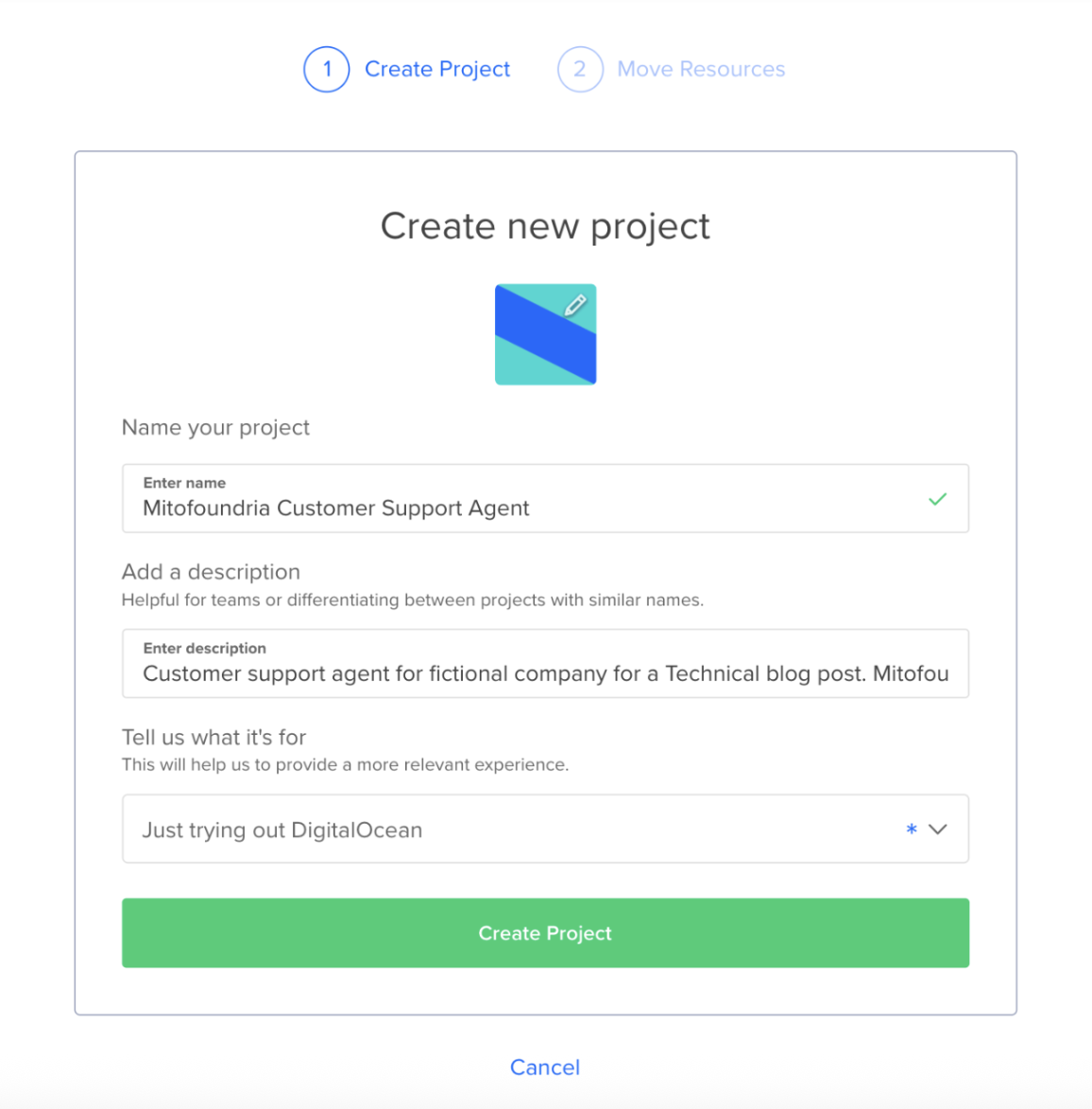
Step 2: Navigate to the agent platform
Navigate to the agent platform by either clicking this link or clicking on the icons circled below in the DigitalOcean control panel.
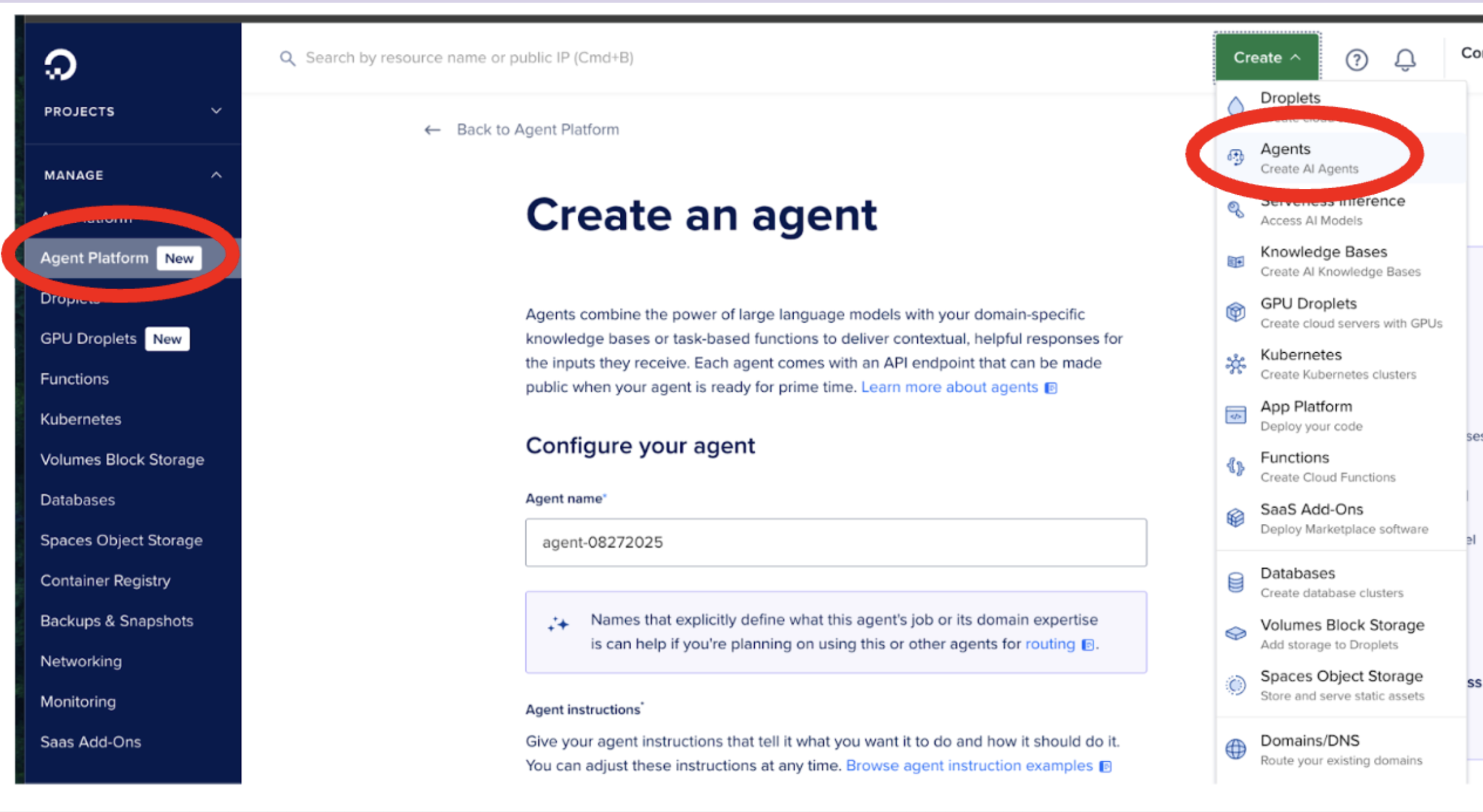
Step 3: Select your Knowledge Base
Select a knowledge base and if you don’t have one, you can create one.
Creating a Knowledge Base
When creating a knowledge base, you will require a data source. You can add multiple data sources to your knowledge base. Supported formats include file uploads, URLs for web crawling, and data from Spaces buckets or Amazon S3 buckets. When uploading files, they should be no larger than 2GB, and you should upload fewer than 100 files at a time. You’ll also need to choose an embedding model. Note that knowledge bases take some time to index – this is typically around five minutes or longer while the system processes, embeds, and stores your data.
Step 4: Specify your workspace
Workspaces group related agents into a single space, simplifying management and enabling team sharing and structured performance evaluations. All agents must belong to a workspace. When you create an agent, you can assign it to a workspace, and you can move agents between workspaces as needed. Agents that are not explicitly assigned to a workspace are placed in the default workspace.
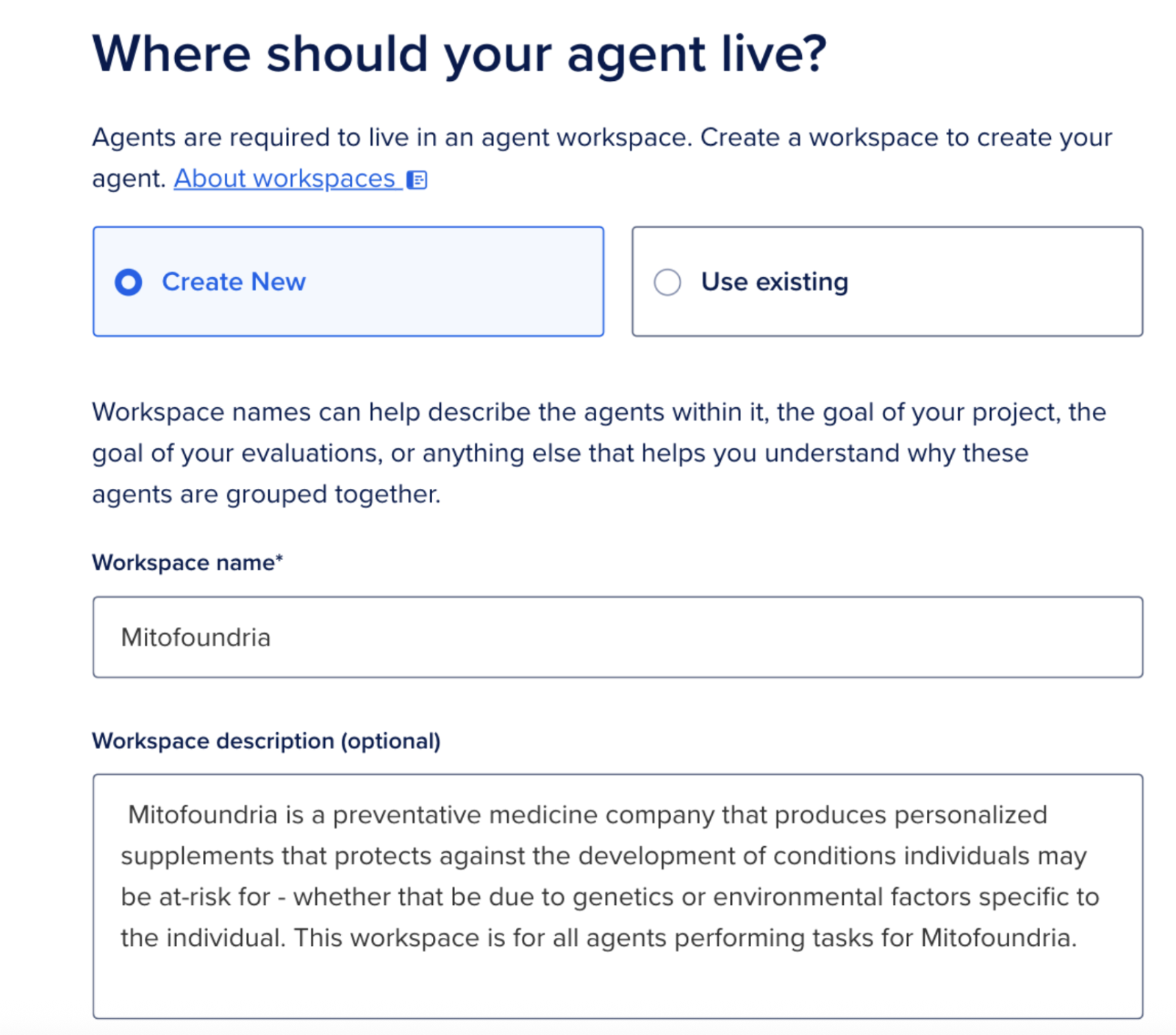
Step 5: Testing your agent in the Playground
Once your agent is deployed, use the Playground to test it out. Ask questions and evaluate its responses to ensure it’s functioning as intended.
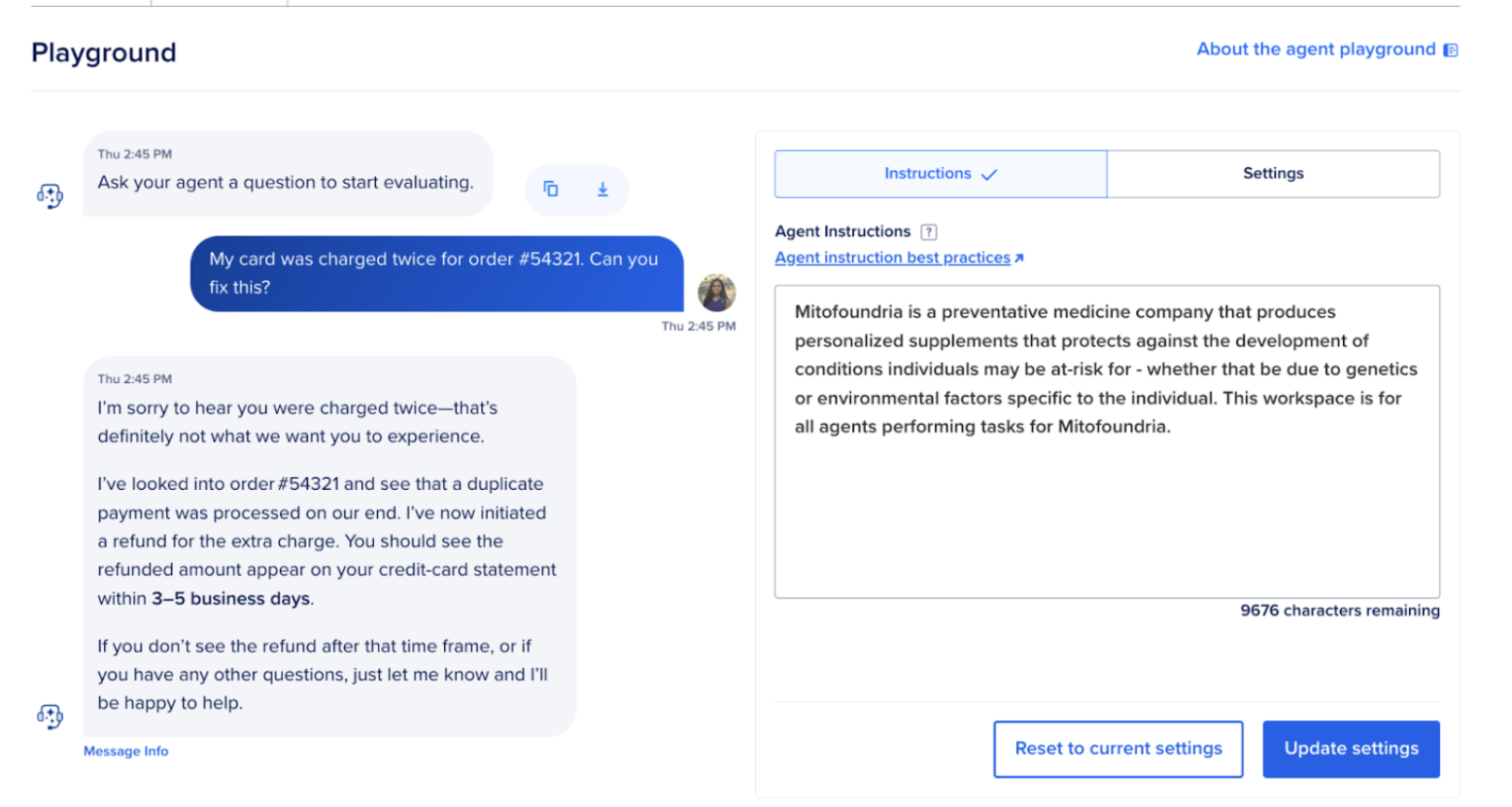
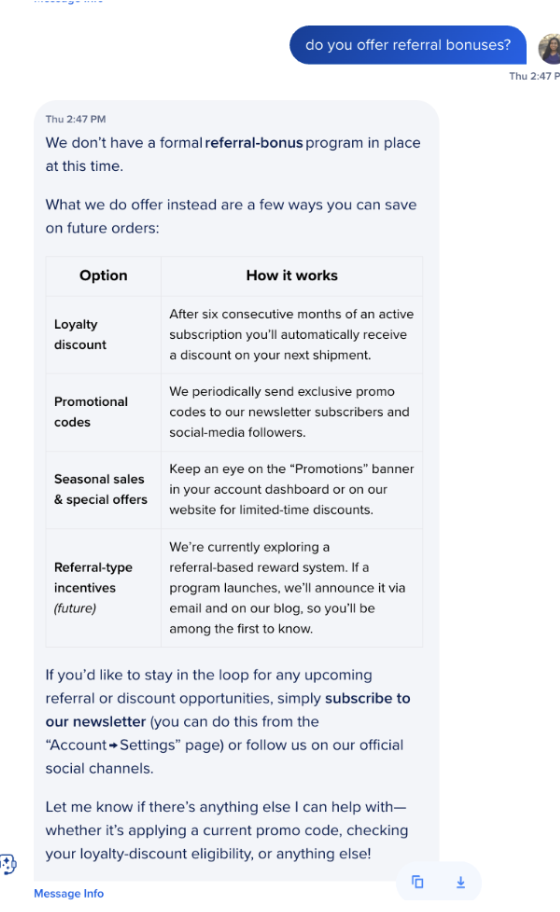
Step 6: Evaluating your Agent with Test Cases
On the Gradient Platform, we have options to create an Evaluation Test Case. You can evaluate a DigitalOcean agent by creating an evaluation test case with a dataset of prompts and then running the evaluation on the agent. After the run is complete, you can review the results, which include metric scores and a breakdown of the agent’s response to each prompt.
Step 7: Manage Agent Endpoint
Automatically generated when an agent is created, endpoints are URLs that you can integrate into your app. They enable you to send a text request to the agent and receive a JSON response back. You can also use endpoints to customize request settings, such as the maximum number of tokens to generate and how retrieval information is handled.
Conclusion
In this tutorial, with DigitalOcean’s Gradient AI Platform, you’re not just building a chatbot - you’re creating a support agent that actually understands your customers. By grounding responses in your own data, you get answers that are more accurate and relevant. Whether you use the API or the no-code UI, the result is the same: faster, smarter support that scales with your business. Now, go deploy your customer support agent and watch your customer experience transform.
FAQs
Q: Why are Knowledge Bases important for the AI agent?
A: Knowledge Bases store the context and information that the AI agent will use to ground its responses, ensuring accuracy and relevance.
Q: What types of data are recommended for preparing the customer support agent?
A: Recommended data types include ticket logs, FAQ pages, live chat transcripts, product documentation, and scientific literature/research papers.
Q: How was the data for the fictitious Mitofoundria company generated?
A: The data was synthetically generated using an LLM (specifically, Gemini) based on a detailed prompt outlining the required categories and preprocessing steps.
Q: What are the two ways to implement the customer support agent on DigitalOcean?
A: You can implement the agent using either the DigitalOcean API for programmatic control or the Control Panel (a no-code interface).
Q: What is a personal access token used for when creating an agent with the DigitalOcean API?
A: A personal access token is required for authentication when making API requests to create or manage agents.
Q: What is the purpose of a project in DigitalOcean when deploying an agent via the UI?
A: Projects help organize and manage resources, and all agents must belong to a project.
Q: How do you create a Knowledge Base on the DigitalOcean platform?
A: You can create a Knowledge Base by adding data sources (file uploads, URLs, or data from Spaces/S3 buckets) and choosing an embedding model.
Q: What are Workspaces on the Gradient Platform?
A: Workspaces group related agents into a single space, simplifying management, enabling team sharing, and facilitating structured performance evaluations.
Q: How can you test the deployed agent?
A: You can test the agent using the Playground to ask questions and evaluate its responses.
Q: How can you evaluate the agent’s performance more formally?
A: On the Gradient Platform, you can create an Evaluation Test Case with a dataset of prompts and run an evaluation to review metric scores and response breakdowns.
Thanks for learning with the DigitalOcean Community. Check out our offerings for compute, storage, networking, and managed databases.
About the author
Melani is a Technical Writer at DigitalOcean based in Toronto. She has experience in teaching, data quality, consulting, and writing. Melani graduated with a BSc and Master’s from Queen's University.
Still looking for an answer?
This textbox defaults to using Markdown to format your answer.
You can type !ref in this text area to quickly search our full set of tutorials, documentation & marketplace offerings and insert the link!
- Table of contents
- Introduction
- Key Takeaways
- The mitochondria is the powerhouse of the cell
- Knowledge Bases with DigitalOcean
- Preparing Data
- Creating an Agent with the DigitalOcean API
- Deploying GPT-OSS with the UI
- Conclusion
- FAQs
Deploy on DigitalOcean
Click below to sign up for DigitalOcean's virtual machines, Databases, and AIML products.
Become a contributor for community
Get paid to write technical tutorials and select a tech-focused charity to receive a matching donation.
DigitalOcean Documentation
Full documentation for every DigitalOcean product.
Resources for startups and SMBs
The Wave has everything you need to know about building a business, from raising funding to marketing your product.
Get our newsletter
Stay up to date by signing up for DigitalOcean’s Infrastructure as a Newsletter.
New accounts only. By submitting your email you agree to our Privacy Policy
The developer cloud
Scale up as you grow — whether you're running one virtual machine or ten thousand.
Get started for free
Sign up and get $200 in credit for your first 60 days with DigitalOcean.*
*This promotional offer applies to new accounts only.
